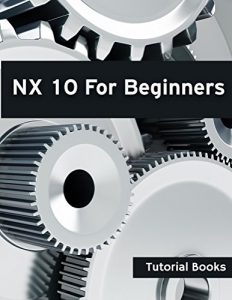NX 10 For Beginners introduces you to the basics of NX 10 by using step-by-step instructions. You begin with brief introduction to NX 10 and the User Interface, ribbon, environments, commands, and various options.
Within a short time, you will learn to create 2D sketches that form the basis for 3D models. You will learn to sketch on three different planes (Front, Top and Right planes). You will use various sketching tools such as line, rectangle, circle, and so on. You will also learn to modify sketches using tools such as trim, extend, fillets, and so on. Learn to use geometric constraints and dimensions to achieve a definite shape and size of the sketch.
Sketches are converted into 3D features such as Extrude, Revolve, and so on. You combine or subtract features to achieve the final part. You can also add placed features (sketch less features) such as Fillets, and Holes to the 3D geometry. You explore mirroring and patterning commands to create repetitive features.
You will learn to use some additional modeling tools and work with multi-body parts. Learn to modify part geometry by editing sketches and feature parameters. You explore Synchronous Modeling tools to modify the Part geometry by modifying its faces.
You build assemblies after creating parts. There are two methods to build assemblies: Bottom-up and Top-down. In the Bottom-up method, you bring all the parts together and add constraints between them. In the Top-down method, you create parts in the assembly level. You explode assemblies to show the manner in which they were assembled.
You create Drawings of the parts and assemblies. You insert part views and add dimensions and annotations to complete the drawing. In case of assembly drawings, you insert assembly views, add Bill of Materials, Balloons, and Revision table.
The Sheet Metal design chapter covers various tools used to build sheet metal parts from scratch. You will also learn to convert an existing part geometry into sheet metal part. You also create flat patterns and 2D sheet metal drawings.
Finally, you explore the surface modeling tools used to create complex shapes.
Table of Contents
1. Getting Started with NX 10
2. Sketch Techniques
3. Extrude and Revolve Features
4. Placed Features
5. Patterned Geometry
6. Additional Features and Multibody Parts
7. Modifying Parts
8. Assemblies
9. Drawings
10. Sheet Metal Design
11. Surface Design
Within a short time, you will learn to create 2D sketches that form the basis for 3D models. You will learn to sketch on three different planes (Front, Top and Right planes). You will use various sketching tools such as line, rectangle, circle, and so on. You will also learn to modify sketches using tools such as trim, extend, fillets, and so on. Learn to use geometric constraints and dimensions to achieve a definite shape and size of the sketch.
Sketches are converted into 3D features such as Extrude, Revolve, and so on. You combine or subtract features to achieve the final part. You can also add placed features (sketch less features) such as Fillets, and Holes to the 3D geometry. You explore mirroring and patterning commands to create repetitive features.
You will learn to use some additional modeling tools and work with multi-body parts. Learn to modify part geometry by editing sketches and feature parameters. You explore Synchronous Modeling tools to modify the Part geometry by modifying its faces.
You build assemblies after creating parts. There are two methods to build assemblies: Bottom-up and Top-down. In the Bottom-up method, you bring all the parts together and add constraints between them. In the Top-down method, you create parts in the assembly level. You explode assemblies to show the manner in which they were assembled.
You create Drawings of the parts and assemblies. You insert part views and add dimensions and annotations to complete the drawing. In case of assembly drawings, you insert assembly views, add Bill of Materials, Balloons, and Revision table.
The Sheet Metal design chapter covers various tools used to build sheet metal parts from scratch. You will also learn to convert an existing part geometry into sheet metal part. You also create flat patterns and 2D sheet metal drawings.
Finally, you explore the surface modeling tools used to create complex shapes.
Table of Contents
1. Getting Started with NX 10
2. Sketch Techniques
3. Extrude and Revolve Features
4. Placed Features
5. Patterned Geometry
6. Additional Features and Multibody Parts
7. Modifying Parts
8. Assemblies
9. Drawings
10. Sheet Metal Design
11. Surface Design






